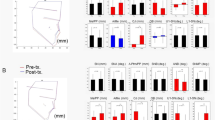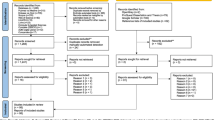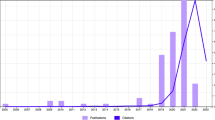Abstract
Artificial intelligence (AI) has been utilized in soft-tissue analysis and prediction in orthodontic treatment planning, although its reliability has not been systematically assessed. This scoping review was conducted to outline the development of AI in terms of predicting soft-tissue changes after orthodontic treatment, as well as to comprehensively evaluate its prediction accuracy. Six electronic databases (PubMed, EBSCOhost, Web of Science, Embase, Cochrane Library, and Scopus) were searched up to March 14, 2023. Clinical studies investigating the performance of AI-based systems in predicting post-orthodontic soft-tissue alterations were included. The Quality Assessment of Diagnostic Accuracy Studies-2 (QUADAS-2) and Joanna Briggs Institute (JBI) appraisal checklist for diagnostic test accuracy studies were applied to assess risk of bias, while the Grading of Recommendation, Assessment, Development, and Evaluation (GRADE) assessment was conducted to evaluate the certainty of outcomes. After screening 2500 studies, four non-randomized clinical trials were finally included for full-text evaluation. We found a low level of evidence indicating an estimated high overall accuracy of AI-generated prediction, whereas the lower lip and chin seemed to be the least predictable regions. Furthermore, the facial morphology simulated by AI via the fusion of multimodality images was considered to be reasonably true. Since all of the included studies that were not randomized clinical trials (non-RCTs) showed a moderate to high risk of bias, more well-designed clinical trials with sufficient sample size are needed in future work.
摘要
近年来,人工智能(AI)被应用于分析和预测正畸面部软组织变化,然而其可靠性尚缺乏系统性评价。本综述概述了AI预测正畸面部变化的研究进展,并对其预测准确度进行综合分析。我们检索了包括PubMed、EBSCOhost、Web of Science、Embase、Cochrane Library和Scopus在内的6个电子数据库(检索日期截至2023年3月14日),纳入了所有使用AI系统对正畸面部变化进行预测的临床研究,并应用QUADAS-2评价表和JBI对诊断性试验的评价表对纳入研究进行偏倚风险分析,同时应用GRADE评价系统进行证据分级。在筛选了2500项研究后,最终有4项非随机临床试验被纳入全文评价。低水平证据表明,AI预测正畸面部变化的总体准确度很高,但其对于下唇和颏部的预测准确度较低。此外,AI通过多模态融合模拟预测的面部形态被认为是合理真实的。然而,由于所有纳入的非随机对照试验研究都显示出中度至高度偏倚风险,因此还需要更多更严谨的临床研究来证实AI在正畸面部变化预测方面的应用价值。
Similar content being viewed by others
Data availability statement
The datasets used and analyzed during the current study are available from the corresponding author on reasonable request.
References
Abiodun OI, Jantan A, Omolara AE, et al., 2019. Comprehensive review of artificial neural network applications to pattern recognition. IEEE Access, 7:158820–158846. https://doi.org/10.1109/ACCESS.2019.2945545
Bral A, Olate S, Zaror C, et al., 2020. A prospective study of soft- and hard-tissue changes after mandibular advancement surgery: midline changes in the chin area. Am J Orthod Dentofacial Orthop, 157(5):662–667. https://doi.org/10.1016/j.ajodo.2019.05.022
Campbell JM, Klugar M, Ding S, et al., 2020. Chapter 9: Diagnostic test accuracy systematic reviews. In: Aromataris E, Munn Z (Eds.), JBI Manual for Evidence Synthesis. JBI, p.309–359. https://doi.org/10.46658/JBIMES-20-10
Chen S, Lou HD, Guo L, et al., 2012. 3-D finite element modelling of facial soft tissue and preliminary application in orthodontics. Comput Methods Biomech Biomed Engin, 15(3):255–261. https://doi.org/10.1080/10255842.2010.522188
Graf CC, Dritsas K, Ghamri M, et al., 2022. Reliability of cephalometric superimposition for the assessment of craniofacial changes: a systematic review. Eur J Orthod, 44(5): 477–490. https://doi.org/10.1093/ejo/cjab082
Holdaway RA, 1983. A soft-tissue cephalometric analysis and its use in orthodontic treatment planning. Part I. Am J Orthod, 84(1):1–28. https://doi.org/10.1016/0002-9416(83)90144-6
Howard J, 2019. Artificial intelligence: implications for the future of work. Am J Ind Med, 62(11):917–926. https://doi.org/10.1002/ajim.23037
Javid AM, Das S, Skoglund M, et al., 2021. A ReLU dense layer to improve the performance of neural networks. Proceedings of the IEEE International Conference on Acoustics, Speech and Signal Processing, p.2810–2814. https://doi.org/10.1109/ICASSP39728.2021.9414269
Karatas OH, Toy E, 2014. Three-dimensional imaging techniques: a literature review. Eur J Dent, 8(1): 132–140. https://doi.org/10.4103/1305-7456.126269
Kasai K, 1998. Soft tissue adaptability to hard tissues in facial profiles. Am J Orthod Dentofacial Orthop, 113(6):674–684. https://doi.org/10.1016/s0889-5406(98)70228-8
Kassem HE, Marzouk ES, 2018. Prediction of changes due to mandibular autorotation following miniplate-anchored intrusion of maxillary posterior teeth in open bite cases. Prog Orthod, 19:13. https://doi.org/10.1186/s40510-018-0213-5
Khanagar SB, Al-Ehaideb A, Vishwanathaiah S, et al., 2021. Scope and performance of artificial intelligence technology in orthodontic diagnosis, treatment planning, and clinical decision-making–a systematic review. J Dent Sci, 16(1):482–492. https://doi.org/10.1016/j.jds.2020.05.022
Leonardi R, Giordano D, Maiorana F, 2009. An evaluation of cellular neural networks for the automatic identification of cephalometric landmarks on digital images. J Biomed Biotechnol, 2009:717102. https://doi.org/10.1155/2009/717102
Lim YN, Yang BE, Byun SH, et al., 2022. Three-dimensional digital image analysis of skeletal and soft tissue points A and B after orthodontic treatment with premolar extraction in bimaxillary protrusive patients. Biology (Basel), 11(3):381. https://doi.org/10.3390/biology11030381
Liu CX, Kong DH, Wang SF, et al., 2021. Deep3D reconstruction: methods, data, and challenges. Front Inform Technol Electron Eng, 22(5):652–672. https://doi.org/10.1631/FITEE.2000068
Lux CJ, Stellzig A, Volz D, et al., 1998. A neural network approach to the analysis and classification of human craniofacial growth. Growth Dev Aging, 62(3):95–106.
Moon JH, Kim MG, Hwang HW, et al., 2022. Evaluation of an individualized facial growth prediction model based on the multivariate partial least squares method. Angle Orthod, 92(6):705–713. https://doi.org/10.2319/110121-807.1
Mörch CM, Atsu S, Cai W, et al., 2021. Artificial intelligence and ethics in dentistry: a scoping review. J Dent Res, 100(13):1452–1460. https://doi.org/10.1177/00220345211013808
Moyers RE, Bookstein FL, 1979. The inappropriateness of conventional cephalometrics. Am J Orthod, 75(6):599–617. https://doi.org/10.1016/0002-9416(79)90093-9
Nanda SB, Kalha AS, Jena AK, et al., 2015. Artificial neural network (ANN) modeling and analysis for the prediction of change in the lip curvature following extraction and non-extraction orthodontic treatment. J Dent Specialities, 3(2):130–139. https://doi.org/10.5958/2393-9834.2015.00002.9
Page MJ, McKenzie JE, Bossuyt PM, et al., 2021. The PRISMA 2020 statement: an updated guideline for reporting systematic reviews. BMJ, 372:n71. https://doi.org/10.1136/bmj.n71
Pan YH, 2021. Miniaturized five fundamental issues about visual knowledge. Front Inform Technol Electron Eng, 22(5): 615–618. https://doi.org/10.1631/FITEE.2040000
Pan YH, 2022. On visual understanding. Front Inform Technol Electron Eng, 23(9):1287–1289. https://doi.org/10.1631/FITEE.2130000
Park JH, Kim YJ, Kim J, et al., 2021. Use of artificial intelligence to predict outcomes of nonextraction treatment of Class II malocclusions. Semin Orthod, 27(2):87–95. https://doi.org/10.1053/j.sodo.2021.05.005
Park YS, Choi JH, Kim Y, et al., 2022. Deep learning-based prediction of the 3D postorthodontic facial changes. J Dent Res, 101(11):1372–1379. https://doi.org/10.1177/00220345221106676
Ricketts RM, 1960. Cephalometric synthesis: an exercise in stating objectives and planning treatment with tracings of the head roentgenogram. Am J Orthod, 46(9):647–673. https://doi.org/10.1016/0002-9416(60)90172-X
Rongo R, Bucci R, Adaimo R, et al., 2020. Two-dimensional versus three-dimensional Fränkel Manoeuvre: a reproducibility study. Eur J Orthod, 42(2):157–162. https://doi.org/10.1093/ejo/cjz081
Ryan R, Hill S, 2016. How to GRADE the quality of the evidence. Cochrane Consumers and Communication Group. http://cccrg.cochrane.org/author-resources
Sample LB, Sadowsky PL, Bradley E, 1998. An evaluation of two VTO methods. Angle Orthod, 68(5):401–408. https://doi.org/10.1043/0003-3219(1998)068<0401:AEOTVM>2.3.CO;2
Scarfe WC, Azevedo B, Toghyani S, et al., 2017. Cone Beam Computed Tomographic imaging in orthodontics. Aust Dent J, 62(Suppl 1):33–50. https://doi.org/10.1111/adj.12479
Schwendicke F, Golla T, Dreher M, et al., 2019. Convolutional neural networks for dental image diagnostics: a scoping review. J Dent, 91:103226. https://doi.org/10.1016/j.jdent2019.103226
Shen DG, Wu GR, Suk HI, 2017. Deep learning in medical image analysis. Annu Rev Biomed Eng, 19:221–248. https://doi.org/10.1146/annurev-bioeng-071516-044442
Soheilifar S, Soheilifar S, Afrasiabi Z, et al., 2022. Prediction accuracy of Dolphin software for soft-tissue profile in Class I patients undergoing fixed orthodontic treatment. J World Fed Orthod, 11(1):29–35. https://doi.org/10.1016/j.ejwf.2021.10.001
Stratemann SA, Huang JC, Maki K, et al., 2008. Comparison of cone beam computed tomography imaging with physical measures. Dentomaxillofac Radiol, 37(2):80–93. https://doi.org/10.1259/dmfr/31349994
Subramanian AK, Chen Y, Almalki A, et al., 2022. Cephalometric analysis in orthodontics using artificial intelligence–a comprehensive review. Biomed Res Int, 2022:1880113. https://doi.org/10.1155/2022/1880113
Tanikawa C, Yamashiro T, 2021. Development of novel artificial intelligence systems to predict facial morphology after orthognathic surgery and orthodontic treatment in Japanese patients. Sci Rep, 11:15853. https://doi.org/10.1038/s41598-021-95002-w
ter Horst R, van Weert H, Loonen T, et al., 2021. Three-dimensional virtual planning in mandibular advancement surgery: soft tissue prediction based on deep learning. J Cranio-Maxillofac Surg, 49(9):775–782. https://doi.org/10.1016/j.jcms.2021.04.001
Toepel-Sievers C, Fischer-Brandies H, 1999. Validity of the computer-assisted cephalometric growth prognosis VTO (Visual treatment objective) according to ricketts. J Orofac Orthop, 60(3):185–194. https://doi.org/10.1007/BF01365265
Tong X, 2022. Three-dimensional shape space learning for visual concept construction: challenges and research progress. Front Inform Technol Electron Eng, 23(9): 1290–1297. https://doi.org/10.1631/FITEE.2200318
Vaz JM, Balaji S, 2021. Convolutional neural networks (CNNs): concepts and applications in pharmacogenomics. Mol Divers, 25(3):1569–1584. https://doi.org/10.1007/s11030-021-10225-3
Wen YF, Wong HM, McGrath CP, 2019. Developmental shape changes in facial morphology: geometric morphometric analyses based on a prospective, population-based, Chinese cohort in Hong Kong. PLoS ONE, 14(6):e0218542. https://doi.org/10.1371/journal.pone.0218542
Whiting PF, Rutjes AWS, Westwood ME, et al., 2011. QUADAS-2: a revised tool for the quality assessment of diagnostic accuracy studies. Ann Intern Med, 155(8):529–536. https://doi.org/10.7326/0003-4819-155-8-201110180-00009
Zhang X, Mei L, Yan XY, et al., 2019. Accuracy of computer-aided prediction in soft tissue changes after orthodontic treatment. Am J Orthod Dentofacial Orthop, 156(6):823–831. https://doi.org/10.1016/j.ajodo.2018.11.021
Zhang XB, Hu Y, Chen W, et al., 2021. 3D brain glioma segmentation in MRI through integrating multiple densely connected 2D convolutional neural networks. J Zhejiang Univ-Sci B (Biomed & Biotechnol), 22(6):462–475. https://doi.org/10.1631/jzus.B2000381
Acknowledgments
The work was supported by the Research Grants Council of the Hong Kong, China (No. 17109619).
Author information
Authors and Affiliations
Contributions
Jiajun ZHU was involved in conceptualization, methodology, investigation, formal analysis, validation, and writing. Yuxin YANG contributed to investigation and writing. Hai Ming WONG was involved in investigation, writing, supervision, and funding acquisition. All authors have read and approved the final manuscript, and therefore, have full access to all the data in the study and take responsibility for the integrity and security of the data.
Corresponding author
Ethics declarations
Jiajun ZHU, Yuxin YANG, and Hai Ming WONG declare that they have no conflict of interest.
This article does not contain any studies with human or animal subjects performed by any of the authors.
Rights and permissions
About this article
Cite this article
Zhu, J., Yang, Y. & Wong, H.M. Development and accuracy of artificial intelligence-generated prediction of facial changes in orthodontic treatment: a scoping review. J. Zhejiang Univ. Sci. B 24, 974–984 (2023). https://doi.org/10.1631/jzus.B2300244
Received:
Accepted:
Published:
Issue Date:
DOI: https://doi.org/10.1631/jzus.B2300244




